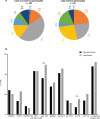Antigen-mediated regulation in monoclonal gammopathies and myeloma
- PMID: 29669929
- PMCID: PMC5931125
- DOI: 10.1172/jci.insight.98259
Antigen-mediated regulation in monoclonal gammopathies and myeloma
Abstract
A role for antigen-driven stimulation has been proposed in the pathogenesis of monoclonal gammopathy of undetermined significance (MGUS) and multiple myeloma (MM) based largely on the binding properties of monoclonal Ig. However, insights into antigen binding to clonal B cell receptors and in vivo responsiveness of the malignant clone to antigen-mediated stimulation are needed to understand the role of antigenic stimulation in tumor growth. Lysolipid-reactive clonal Ig were detected in Gaucher disease (GD) and some sporadic gammopathies. Here, we show that recombinant Ig (rIg) cloned from sort-purified single tumor cells from lipid-reactive sporadic and GD-associated gammopathy specifically bound lysolipids. Liposome sedimentation and binding assays confirmed specific interaction of lipid-reactive monoclonal Ig with lysolipids. The clonal nature of lysolipid-binding Ig was validated by protein sequencing. Gene expression profiling and cytogenetic analyses from 2 patient cohorts showed enrichment of nonhyperdiploid tumors in lipid-reactive patients. In vivo antigen-mediated stimulation led to an increase in clonal Ig and plasma cells (PCs) in GD gammopathy and also reactivated previously suppressed antigenically related nonclonal PCs. These data support a model wherein antigenic stimulation mediates an initial polyclonal phase, followed by evolution of monoclonal tumors enriched in nonhyperdiploid genomes, responsive to underlying antigen. Targeting underlying antigens may therefore prevent clinical MM.
Keywords: Antigen; Cancer; Oncology.
Conflict of interest statement
Figures






References
Publication types
MeSH terms
Grants and funding
LinkOut - more resources
Full Text Sources
Other Literature Sources
Medical

